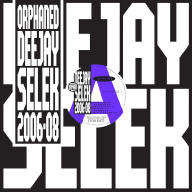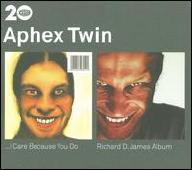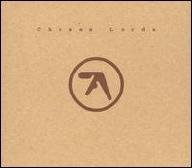James began taking apart electronics gear as a teenager growing up in Cornwall, England. (If the title Selected Ambient Works 85-92 is to be believed, it contains recordings made at the age of 14.) Inspired by acid house in the late '80s, James began DJ'ing raves around Cornwall. His first release was the Analogue Bubblebath EP, recorded with Tom Middleton (who co-produced the hardcore track "En Trance to Exit") and released on the Mighty Force label in September 1991. Middleton left later that year to form Global Communication, after which James recorded a second volume in the Analogue Bubblebath series. This EP (the first to include "Digeridoo") got some airplay on the London pirate radio station Kiss FM, and prompted Belgium's RS Records to sign him early the following year. A re-release of "Digeridoo" made number 55 in the British charts just after its April 1992 release date, and James followed with the Xylem Tube EP in June. He also co-formed (with Grant Wilson-Claridge) his own Rephlex label around that time, releasing a series of singles as Caustic Window during 1992-1993. Available in cruelly limited editions, most of the recordings continued the cold acid precision of "Digeridoo" -- though several expressed humor and fragility barely dreamed of in the hardcore/rave scene to that point.
The climate for "intelligent" techno had begun to warm in the early '90s, though. The Orb had proved the commercial viability of ambient house with their chart-topping "Blue Room" single, and RS founded an ambient subdivision called Apollo. In November 1992, James made his full-length debut with Selected Ambient Works 85-92, consisting mostly of home material recorded during the past few years. Simply stated, it was a masterpiece of ambient techno, the genre's second work of brilliance after the Orb's Adventures Beyond the Ultraworld. As his star began to shine, several bands approached him to remix their work, and he complied, with mostly unrecognizable reworkings of tracks by St. Etienne, the Cure, Jesus Jones, Meat Beat Manifesto, and Curve.
Early in 1993, Richard James signed to Warp Records, the influential British label that virtually introduced the concept of futuristic "electronic listening music" with a series of albums (subtitled Artificial Intelligence) by ambient techno pioneers Black Dog, Autechre, B12, and FUSE (aka Richie Hawtin), among others. James' release in the series, titled Surfing on Sine Waves, was recorded as Polygon Window and released in January 1993. The album charted a course between the raw muscle of James' nosebleed techno and the understated minimalism of Selected Ambient Works. A deal between Warp and TVT gave Surfing on Sine Waves an American release (James' first) by the summer. A second album was released that year, Analogue Bubblebath 3, for Rephlex. Recorded as AFX, the LP renounced any debt to ambient music and was the most bracing work yet in the Aphex Twin canon. On a tour of America with Orbital and Moby later that year, James clung to the headbanging material, to the detriment of his mostly irreplaceable gear. He later cut down on his live performance schedule.
In December of 1993, the new single "On" resulted in James' highest chart placement to that point, a number 32 spot on the British charts. The two-part single included remixes by old pal Tom Middleton (as Reload) and future Rephlex star µ-Ziq (Michael Paradinas). Despite James' appearance on the pop charts, his following album, Selected Ambient Works, Vol. II, appeared to be a joke on the ambient techno community. So minimal as to be barely conscious, the quadruple album left most of the beats behind, with only tape loops of unsettling ambient noise remaining. The album hit number 11 on the British charts and earned James a major-label American contract with Sire soon afterward. During 1994, he worked on the ever-growing Rephlex stable, signing µ-Ziq, Kosmik Kommando (Mike Dred), and Kinesthesia/Cylob (Chris Jeffs) to the label. In August 1994, he released the fourth Analogue Bubblebath, this one a five-track EP.
The year 1995 began with the January release of Classics, a compilation of his early RS singles. Two months later, James released the single "Ventolin," a harsh, appropriately wheezing ode to the asthma drug on which he relied. I Care Because You Do followed in April, pairing his hardcore experimentalism with more symphonic ambient material, aligned with the work of many post-classical composers -- including Philip Glass, who arranged an orchestral version of the album's "Icct Hedral" on the August 1995 single Donkey Rhubarb.
Later that year, the Hangable Auto Bulb EP replaced Analogue Bubblebath 3 as Aphex Twin's most brutal, uncompromising release -- a fusion of experimental music and jungle being explored at the same time on releases by Plug and Squarepusher. In July 1996, Rephlex released the long-awaited collaboration between Richard James and µ-Ziq. The album, Expert Knob Twiddlers (credited to Mike Rich), watered down the experimentalism of Aphex Twin with µ-Ziq's easy listening electro-funk. The fourth proper Aphex Twin album, November 1996's Richard D. James Album, continued his forays into acid-jungle and experimental music. Retaining the experimental edge, but with a stated wish to make the British pop charts, James' next two releases, 1997's Come to Daddy EP and 1999's Windowlicker EP, were acid storms of industrial drum'n'bass. The accompanying videos, both directed by Chris Cunningham, featured the bodies of small children and female models (respectively) dancing around, all with special-effects-created Aphex Twin faces grinning maniacally.
James released nothing during the year 2000, but did record the score to Flex, a Chris Cunningham short film exhibited as part of the Apocalypse exhibition at London's Royal Academy. With very little advance warning, another LP, Drukqs, finally arrived in late 2001. One of James' most polarizing releases, it has nonetheless produced one of his most enduring compositions, the delicate piano piece "Avril 14th," which has appeared in several films and television programs in addition to being sampled by Kanye West.
Although James continued making frequent DJ appearances, he released no more material until 2005, when Rephlex issued the first installment in a lengthy, 11-part series of 12" singles titled Analord. The singles' minimalist acid techno harked back to his Caustic Window/Analogue Bubblebath material of the early '90s. Chosen Lords, a CD compilation of some of the Analord material, appeared in April 2006. James continued to DJ and play live, and in 2009 the Rushup Edge LP appeared under the performer name of the Tuss; although James and Rephlex denied that it was his work, rumors persisted that it was yet another Aphex pseudonym. Additional rumors during the late 2000s promised releases from James, but they proved unfounded. However, in 2014, an extremely rare acetate of a shelved 1994 Caustic Window album was auctioned for sale, bought via a crowdfunding campaign, and distributed digitally to the contributors. The physical copy was then bought by the creator of the popular video game Minecraft for over $46,000, with the money split between James, the contributors, and a charity.
That August, a green blimp sporting the Aphex Twin logo was spotted flying over London; by the end of the following month, Warp released Syro, the first Aphex Twin album in over a dozen years. Syro went on to win a Grammy for Best Dance/Electronic Album. Only three months later, James uploaded over 30 previously unreleased recordings available as a free download. In early 2015, Warp issued an EP, Computer Controlled Acoustic Instruments, Pt. 2. Later that year, after James' uploads of free tracks exceeded 100, the producer revived his AFX alias for another Warp EP, the more substantive Orphaned Deejay Selek 2006-2008. He eventually took the freebies down, but at least one of them surfaced on his next EP, 2016's Cheetah. Rare live performances followed into 2017, with bread crumbs scattered for fans via in-store-only record sales and an online store. In the summer of 2018, James kicked off another mysterious street advertising campaign. The Aphex Twin logo was found in London, Turin, and Los Angeles, but no further details were provided. That September, he released the Collapse EP, which featured the glitchy single "T69 Collapse." ~ John Bush, Rovi









